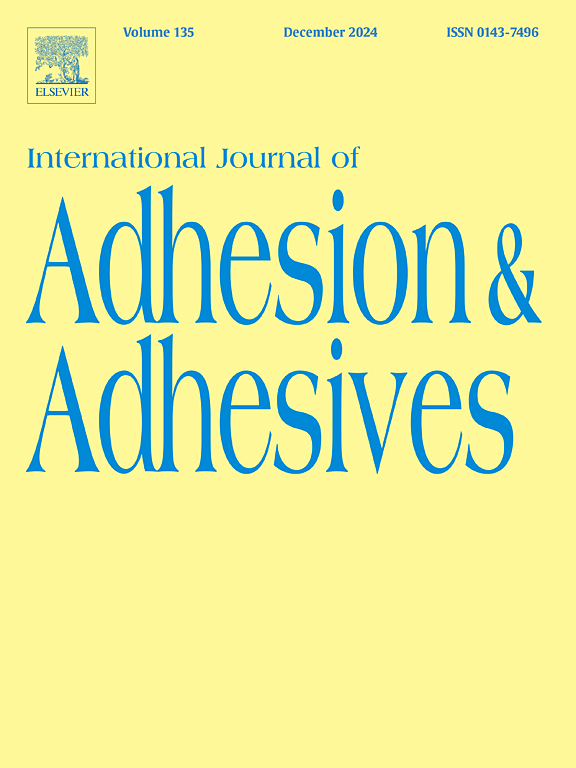粘接补片加强封堵孔修补的粘接应力估计
IF 3.5
3区 材料科学
Q2 ENGINEERING, CHEMICAL
International Journal of Adhesion and Adhesives
Pub Date : 2025-09-17
DOI:10.1016/j.ijadhadh.2025.104158
引用次数: 0
摘要
疲劳裂纹的粘结修补方法因其应用迅速、避免了截面损失等优点而受到人们的关注。本文主要研究了粘结补片加固封堵孔的方法。该方法安装简单,减少了从停止孔重新产生裂缝的可能性。修复后的疲劳寿命受两种机制的影响:一是止裂孔处裂纹的再萌生,二是胶粘剂的内聚失效。在以往的研究中,研究了影响止孔疲劳强度的应力集中因素,这些因素与裂纹再萌生有关。而与胶粘剂内聚破坏有关的粘接应力尚未得到充分的研究。进行有限元分析以评估胶粘剂中的剪切、法向和最大主应力,并开发了估算这些应力的理论公式。考虑了两种修复方案:一种是中心补片修复模型,即补片在裂纹中心粘接;另一种是偏心补片修复模型,即补片偏心粘接以避免与折板的干扰。开发的配方表明,粘合剂的最大主应力范围在0.20至0.26 MPa之间,中心补丁修复和0.22至0.28 MPa之间,取决于板的宽度。胶粘剂的预测应力分布与有限元结果吻合较好。这些发现为粘接补片封堵孔修复的疲劳设计提供了有用的见解,可以更精确地考虑粘接的内聚破坏。本文章由计算机程序翻译,如有差异,请以英文原文为准。
Estimation of adhesive stress for bonded patches to strengthen stop-hole repair
Bonded patch repair methods for fatigue cracks have gained attention due to advantages such as rapid application and avoidance of cross-sectional loss. This study focuses on stop-hole repair strengthened by bonded steel patch plates. The method offers simple installation and reduces the likelihood of crack reinitiation from the stop-hole. The fatigue life after repair is governed by two mechanisms: crack reinitiation at the stop-hole and cohesive failure of the adhesive. In previous studies, stress concentration factors affecting stop-hole fatigue strength have been investigated, which are related to crack reinitiation. On the contrary, adhesive stress, which is related to cohesive failure of the adhesive, has not yet been fully investigated. Finite element (FE) analysis was conducted to evaluate shear, normal, and maximum principal stresses in the adhesive, and theoretical formulation were developed to estimate these stresses. Two repair scenarios were considered: a central patch repair model, in which patch plates were bonded at the crack center, and an eccentric patch repair model, in which patch plates were bonded eccentrically to avoid interference with gusset plates. The developed formulation showed that the maximum principal stress in the adhesive ranged from 0.20 to 0.26 MPa for central patch repairs and from 0.22 to 0.28 MPa for eccentric patch repairs, depending on plate width. The predicted stress distributions of the adhesive showed good agreement with the FE results. These findings provide useful insights into the fatigue design of stop-hole repairs with bonded patches, enabling more precise consideration of adhesive cohesive failure.
求助全文
通过发布文献求助,成功后即可免费获取论文全文。
去求助
来源期刊

International Journal of Adhesion and Adhesives
工程技术-材料科学:综合
CiteScore
6.90
自引率
8.80%
发文量
200
审稿时长
8.3 months
期刊介绍:
The International Journal of Adhesion and Adhesives draws together the many aspects of the science and technology of adhesive materials, from fundamental research and development work to industrial applications. Subject areas covered include: interfacial interactions, surface chemistry, methods of testing, accumulation of test data on physical and mechanical properties, environmental effects, new adhesive materials, sealants, design of bonded joints, and manufacturing technology.
 求助内容:
求助内容: 应助结果提醒方式:
应助结果提醒方式:


